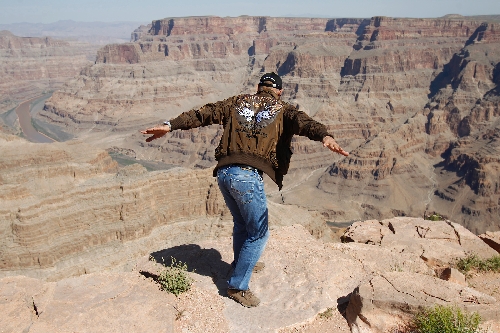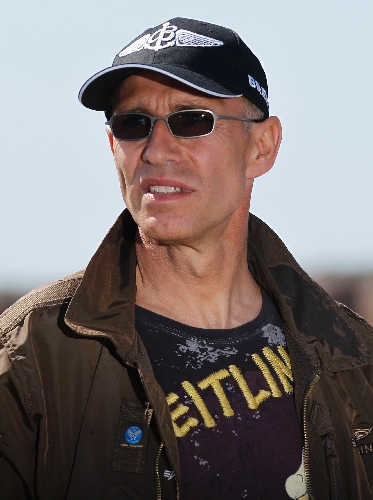“JetMan’s” Grand Canyon flight called off
GRAND CANYON WEST -- Like some real-life Wile E. Coyote, Swiss aviator Yves Rossy was going to strap a homemade jet-propelled wing to his back and shoot across the desert Friday morning.
Same as the Coyote, Rossy's 120-mph flight through a slot of the Grand Canyon, two hours east of Las Vegas, went awry. But it didn't end in one of the calamitous climaxes of the clumsy Coyote. Rossy's feet never left the ground. The public didn't even get a glimpse of Rossy's 120-pound contraption resembling the wing of "Toy Story's" Buzz Lightyear.
Two dozen members of the media waited at Guano Point overlooking the Colorado River, expecting Rossy -- nicknamed the "JetMan" -- to fly by at 9 a.m. Friday. The plan was for Rossy, 51, to jump off a helicopter and streak back and forth at eye level through the canyon for about 15 minutes. Once the fuel for his four jet engines ran out, he would parachute to the bank of the river 4,000 feet below. A helicopter then would pick him up.
Rossy was a no-show until 9:45. He stepped out of an arriving car and approached the journalists who had come from around the globe, representing Discovery Channel Canada, Agency France Press, Chinese press, The Associated Press, Reuters, Sports Illustrated and more. The flight cancellation was apparent from Rossy's attire: jeans, a baseball cap and a flight jacket, not his usual skintight flight suit.
"Without training, I don't want to take the risk," he said. "I hope you understand I'm a human, a human flying."
Rossy has been flying ever-evolving models of his wing for 15 years, crossing the 30-mile English Channel in 2008 and completing two vertical loops over a field in Switzerland, but he has never navigated between obstacles, such as the Grand Canyon's sheer rock faces.
Rossy has always flown in open flat places where he can land just about anywhere in case things go wrong, which they did in November 2009. He was attempting to make the first intercontinental crossing by jet-wing, flying from Morocco to southern Spain. Because of bad weather, he had to drop his wing and open his parachute, landing at sea.
To prepare for Friday, he planned a half-dozen training flights through the canyon over the preceding days. However, he couldn't go up in the air even once because his wing wasn't certified by the Federal Aviation Administration.
Rossy was "extremely" nervous about tackling the canyon without trial runs, said John Bishop of H5 Productions, a helicopter videography company that Rossy hired to record the event.
"There are so many variables. You got thermals, wind currents, shadows," he said. "And this isn't an airplane. He's the airplane."
Rossy doesn't use any instruments besides a lever in his hand to adjust the speed of the four jet engines. He turns by twisting his shoulders, his arms straight down his sides. He ascends by arching his back and head, and dives by hunching down, "just like a bird," Bishop said.
Rossy received FAA approval for the flight at 9 a.m. Friday, just in time for the grand event, his first U.S. flight. But he called it off anyway after two years of planning.
"This is the most challenging place I could fly," he said.
If and when the flight will be rescheduled remains to be seen. Rossy would like to fly the Grand Canyon for his first flight in America.
"But now I need a little bit of distance to reconsider it," he said before walking to the cliff's edge for some photos.
It appeared Thursday night that the flight might be canceled because FAA officials still were inspecting the wing.
FAA officials said Rossy and his sponsor, Swiss watchmaker Breitling, never approached them to get approved for his wing, deemed an "experimental aircraft." Instead, the FAA had to contact Rossy a couple weeks ago to inform him that though the Hualapai Indians had said he could fly over their land, the U.S. government controls all airspace, reservation or not.
Stephan Degen, manager of the Grand Canyon West Airport, has been Rossy's point man with the FAA. Rossy had the reservation's approval three months ago, Degen said, but FAA approval was not sought until FAA officials made contact.
"The focus was on getting here," Degen said.
In the end, the Coyote decided the Road Runner wasn't worth the risk.
Contact reporter Trevon Milliard at tmilliard@review journal.com or 702-383-0279.




















